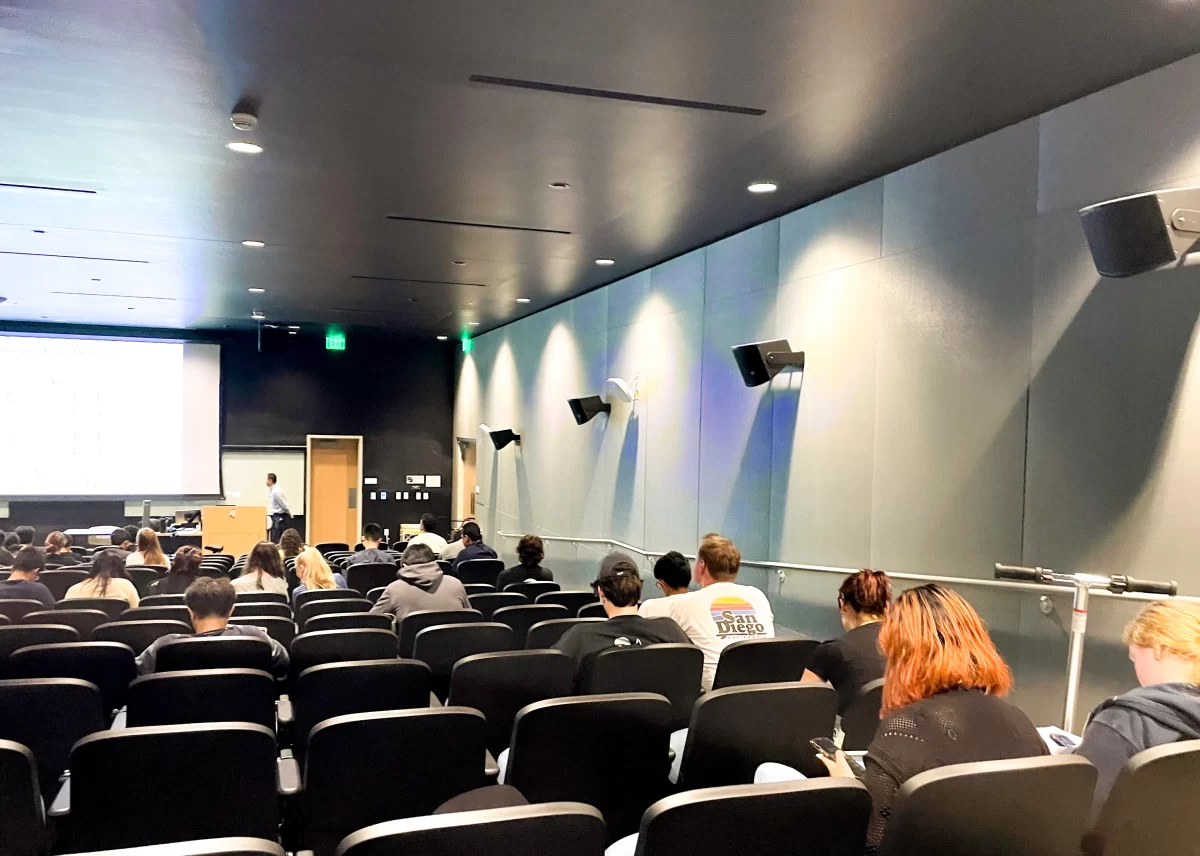Students and teachers must constantly make choices about the role of technology in classrooms, balancing dwindling attention spans, opportunities for distraction, and our capacity to learn.
According to one Microsoft study, the average member of Gen Z has an attention span of eight seconds, nearly 30% less than our millennial counterparts. These Gen Z-ers inhabit UC San Diego’s lecture halls, trying to earn their degrees over some infinite number of eight-second bursts of attention.
But what happens when eight seconds is up, when we lose interest? When we feel the need to do something else, hear something else, think about something more interesting, or find another form of stimulation? Look at your phone, perhaps. Flip to another tab, shop for that shirt you’ve been wanting, or respond to that text from your mom. How easy was that?
The ease with which any student makes the choice to redirect their attention is just one example of Gen Z’s ever-growing capacity to be distracted. It’s a constant push and pull between the desire to learn, to focus in lecture and listen to what your professor is saying, and the restraint it requires to not choose one of the million options waiting for you on another screen.
With the exponential growth of technology as a resource (and burden) in all facets of our lives, it’s hard not to attribute our decreased attention spans to technology-related factors. Do our short attention spans signify the inability of students to focus in lectures? Have our decreased attention spans and capacity for electronic-related distraction hindered our concentration and learning permanently?
Sociology professor Kevin Lewis said that he has faith in students’ ability to focus in a technology-free space.
“I think that a lot of students do have a short attention span, but once we take away the opportunities to distract ourselves, and try and meet them in that space being excited and enthusiastic, it’s been just fine,” he said.
On the first day of his class, Lewis asks his students to put away all devices and keep them away for the remainder of the quarter, opting for notes on paper instead. He aims to create a distraction-free classroom where students can best absorb and synthesize knowledge through longhand notes.
In the study that Lewis shares with his class at the beginning of each quarter, participants were tested on their comprehension ability in two different conditions: taking notes on paper and on a computer. Students who typed tended to transcribe notes verbatim, revealing a more shallow level of processing than those who took synthesized notes longhand.
Armand Tufenkian, a lecturer for the visual arts department, teaches his film classes in a similar, technology-free environment. With the exception of graduate thesis writing, where, of course, most students type their theses, Tufenkian asks students to put their computers and devices away. In the context of watching films, he feels that devices are more of a distraction than a tool for learning.
Both Lewis and Tufenkian create a space where students who need accommodations are able to get them when needed. Tufenkian noted that any student who has particular needs or requests would be met with flexibility. Lewis expressed a similar sentiment.
Lewis described the dilemma that accompanied his choice, especially in the wake of COVID-19 and alongside an increasingly diverse UCSD population.
“I don’t like kind of inadvertently singling out [students with accommodations], I’m not sure of a way to get around that, and that’s my only hesitation,” he said.
Tufenkian and Lewis described an overall positive response from students upon their request to rid the class of technology. But not every classroom caters to this kind of note-taking. Sixth College junior Hayden Kirkeide said that she chooses her note-taking strategy according to the class.
In faster-paced courses that require copying down lots of information from slides, Kirkeide uses her laptop. Although she chooses to type when it feels necessary for the course, Kirkeide admits that having her laptop in class can be distracting.
“If you have a stronger will than me, you will likely pay more attention. I can get distracted,” she said.
Kirkeide isn’t alone in having trouble resisting temptation. It isn’t uncommon to look to your left in class to see someone switching between screens, perhaps typing their notes whilst responding to messages on a split screen. Each student chooses their own academic or personal agenda during lectures.
Educators can only imagine what happens behind those screens, their view obstructed by bedazzled laptop cases and the pitter patter of dozens of fingers tapping on keyboards. There’s neither a visible nor audible distinction between a distracted student and a present one.
Eleanor Roosevelt College senior Sahar Alfatlawi said that she believes that teachers need to “keep up with the times.” Alfatlawi highlighted the highly pervasive nature of technology in our current schooling, with many of our tests, resources, and assignments existing in the online domain.
“We’ve evolved all of our schools online, on Canvas…. It should be appropriate to have digital copies of things like notes,” she said. Though she understood why some professors might take a more traditional approach — like those teaching languages requiring verbal and written skills — she found it difficult to understand why other professors should be able to make that choice when the rest of students’ educational experience revolves around technology.
Of course, some people might characterize the nature of assignments and tests as part of an entirely different realm from the ways we judge how content is learned. The purpose of going to school at all, of attending lectures with professors and sitting in a class, is to have a well-rounded and engaging educational experience. Shouldn’t part of that experience be defined by our presence in class, both mentally and physically, and isn’t that aspect of education distinct from the asynchronous features?
Instructors must find ways to be effective in this new learning environment. It’s their job to find a way to cater to the new generation, and it’s students’ job to learn, whether technology plays a role or not. Lewis understands that it takes a certain amount of commitment and preparation to teach a group of students without the comfort of their laptops and phones in the classroom.
“You can’t just ask students to do something without meeting them in the space that you’ve just created,” he said. Lewis does his best to foster an engaging space for students to learn without the pressure of copying down copious amounts of information or going hours without interaction and reflection.
Both Lewis and Tufenkian have also made the choice to stop podcasting their lectures, post-COVID-19. Lewis found that attendance in lectures dropped drastically when they were podcasted; his classrooms were sparsely filled with only a dozen students on an average day.
Students might choose to miss class simply out of convenience. Why would you travel all the way to class at 8 a.m. when you could get three more hours of sleep and watch the lecture from the comfort of your bed just a few hours later? You could speed it up, go on your phone while you watch, and eat your breakfast all while “attending” class.
As great as that may sound, could anyone really call that learning? The whole point of restricting technology use in the classroom is undermined when the lecture itself exists as a figment of something abstract, far away, online.
“At what point does it become indistinguishable from an online class or a class with no instructor at all?” Lewis asked.
Kirkeide has found herself struggling to even watch lectures at all when they’re podcasted or pre-recorded; forced to learn content solely from lecture slides or through assignments, she felt as though she was effectively taking a course with no instructor at all. Her performance dropped when she wasn’t able to experience class in person.
“I really didn’t learn anything … I didn’t have any motivation to study, no motivation to participate,” Kirkeide said.
Lewis added, “I think again that’s a fundamentally different experience than actually engaging you live and being in that space together.”
Despite struggling to watch podcasts, Kirkeide sees a few upsides to having lectures recorded. Students have the chance to revisit material they missed or didn’t understand, and recordings serve as a sort of audit for events and behavior in classrooms. However, when podcasts are an option, instructors may struggle to garner motivation for their students to attend in person.
Kirkeide suggested that teachers incentivize attendance in different ways, perhaps with in-person activities that count for part of one’s grade but are not heavily weighted in grades, or by giving students extra credit for attending in person for a certain number of lectures. If students felt motivated to come to the lecture but were also able to look back at content with podcasts, they’d reap the benefits of both in-person learning and recorded content.
The educators who make the bold choice to ban technology, whether that’s through disallowing laptops or refusing to podcast, are not just trying to meddle. They grapple with the same dilemmas as students, making active choices about their methods. They must balance their own convenience and ability to engage classrooms with the wellbeing of their students’ educational experience.
Whether those choices are universally beneficial, or even applicable in some classes, is a question that remains unanswered.
“In a hypothetical world, without technology in the classroom, where no one was using laptops or cellphones or podcasts or PowerPoints, I think without a doubt it would be a more enjoyable space, a space with more learning, a space where students felt like they were getting more for their education, building community and solidarity,” Lewis said.
In some ways, technology has converted students into consumers who want less for their money — less time in class, fewer assignments, and less responsibility. While students weigh convenience, learning styles, and their technology-induced dwindling attention spans, professors will make the choices they see most fitting for students’ learning, whether that means enforcing rules or not. Of course, the hypothetical tech-free world remains a fantasy. Only time will tell how we deal with reality.















